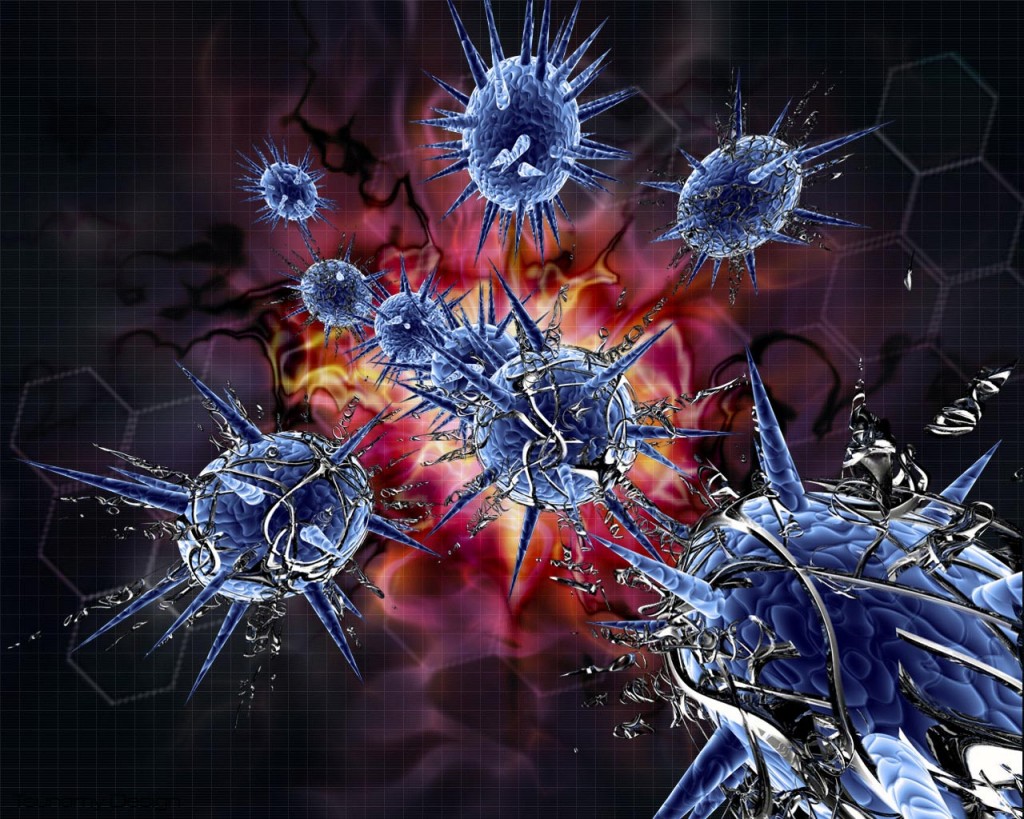Before we can really understand vaccines it is important to understand pathogens and the body’s response to them.
When an infectious agent enters the body, the body will attempt to identify and attack the agent. Infectious agents can be bacteria, foreign bodies, toxins, virus- really anything that does not belong. A virus must have the cell of another organism to replicate. Viruses are considered to be the most abundant biological entity and can infect everything from animals and plants to even bacteria. There are literally MILLIONS of different viruses. Viruses use many different means for spreading infection from employing vectors, such as blood sucking insects, to more direct routes like fecal- oral contamination, body fluids or even becoming airborne and transmitted by sneezing, coughing, etc. When a virus invades a host body, it attempts to enter a cell where it can reproduce and send thousands of other infectious viruses to other cells to continue the cycle and hope to overwhelm the host before the host’s body can mount a defense. The body’s defense mechanism is to make antibodies. These “Y” shaped antibodies attached to the virus rendering it incapable of bonding to and entering in the host’s cell. Antibodies are like little soldiers whose only purpose is to bind with the virus and make sure it gets destroyed. When the antibodies bind to the virus, they also “tag” the virus so that the body’s white blood cells can then destroy the virus. With a viral infection, it is usually a race between the replicating power of the virus and the immune response of the host. This is why when you are sick, it is said the virus needs to “run its course”. The amount of time it takes the body to recognize the virus, produce antibodies and effectively eradicate the virus varies with viruses, as well as the amount of damage the virus can do before a defense is mounted.

Here is a short video that illustrates the immune response: http://www.youtube.com/watch?v=lrYlZJiuf18&feature=related
VACCINATION

The purpose of vaccinations is to introduce enough of the pathogen (virus or bacteria) to elicit an immune response without harming the host. Once antibodies are created, B-Cells keep a memory of that virus and the antibody needed reducing the response time. This way, if that virus were to invade, the antibodies, or soldiers, would already be ready, armed and waiting.
There are 2 main types of possible vaccinations.
A “killed” virus vaccine. This is where the virus has been killed. The body still recognizes it as a pathogen and makes antibodies, but the virus is not capable of causing harm as it is no longer viable.
A MLV or modified live virus vaccination is a vaccine in which the virus has been modified and rendered ineffective but is still alive.
Many people operate under the false presumption that there is a certain number of shots that must be given. It is not a mater of quantity, it is a matter of timing.

When a puppy is born, the first milk he drinks from mom is called cholostrum. This is the first milk she produces and it contains all the antibodies she has as well as digestive bacteria a puppy needs to seed his gut (healthy bacteria vital for digestion). A puppy is born with a sterile gut- without mom seeding it with good bacteria to digest the food, she will be incapable of absorbing nutrients from her food. Depending on the individual titer (concentration of antibodies) of mom and how much of the cholostrum each puppy consumes, the amount of antibodies in each individual puppies will vary greatly. One of the reasons we are hypervigilant on tracking the exact nursing times for each puppy based on the color of ribbon during the first 72 hours and weighing every 12 hours is to make sure that the smaller pups who tend to get pushed off the nipples by the bigger pups still get sufficient quantities of mom’s cholostrum to help assure no attrition. As stated, each individual puppy will have a slightly different titer (concentration of antibodies). That number will continuously decrease as he ages. Unless the mom was immunocompromised (sick and unable to produce antibodies- like an anto-immune disorder such as leukemia, etc.- or for us humans, diseases like AIDS), failed to produce sufficient cholostrum, or the puppy did not nurse from mom during the first 24 hours after birth, the initial vaccination of puppies is typically useless. When we give the first vaccination at 6 weeks, in a typical, healthy pup and mom, the pup will still have a high enough load of antibodies from mom (titer) that HER antibodies bind with the vaccine so that the vaccine does not stimulate the puppy to begin producing his own antibodies. As his titer diminishes weekly, we try again in a couple weeks and continue to try until we hit that magic number where the titer is not so low that he is compromised and at risk of infection, but low enough so that mom’s antibodies do not bind completely with all of the vaccine that is injected and his body can respond by producing his own antibodies. The magic number for most pups is 10-12 weeks of age- but because it varies greatly depending on each mom and each pup’s intake puppy vaccinations should start before and continue after in case mom had a super load and the pup’s titer was still too high at the 10 week vaccination. Because Rottweilers are one of the breeds that is more susceptible to Parvo, we then continue vaccinating until the puppy is between 16-20 weeks of age. We ultimately hope that the last 1-2 vaccinations are not really necessary because the puppy has already started producing his/her antibodies from one of the previous vaccines, but because we do not know for sure, we obviously do not want to run the risk that mom’s antibodies were still too strong and were able to bind with the vaccination before the puppy could mount an immune response.
Many vets still recommend vaccinating annually, but many studies suggest that this is no longer necessary. What we recommend here is to run a titer annually to see if the dog does indeed need to be revaccinated or not. Otherwise, every 3 years is now considered by most current studies sufficient. The only exception to this rule we make here at Guardian Rottweilers is with our breeding females. We vaccinate our breeding females with DHPP annually regardless because we want their titers kept as high as possible for passing on as much immunity as possible to their puppies. Furthermore, when our females travel, we also have then vaccinated overseas just incase there are any variants. As always, please consult with your vet for any and all vaccine questions. The information provided on this page is here for educational purposes only as well as to inform everyone of our practices here. However, I am not a veterinarian and any information here should never take the place of veterinary advice.














